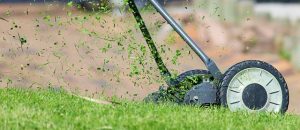Mastering Lawn Care: Tips for Thriving Gardens and Vibrant Landscapes
Effective lawn care and landscaping are essential for creating an attractive and resilient outdoor s…….

Effective lawn care and landscaping are essential for creating an attractive and resilient outdoor space that stands out in the neighborhood. Regular mowing at the correct height—between 2.5 to 4 inches—for your specific grass type promotes healthy root growth and deters weeds. Aeration should be performed frequently to relieve soil compaction, while tailored fertilization based on local soil types and grass species ensures optimal nutrient uptake. Smart irrigation systems help maintain a lush yard while conserving water. Integrating these practices with strategic landscape design enhances both the visual appeal and sustainability of your property, demonstrating a commitment to excellence in lawn care and landscaping. Understanding soil types and their properties is vital for garden health; different soils require specific amendments—like adding organic matter to sandy soils or improving aeration in clay soils—to maintain soil fertility and pH levels for a thriving garden ecosystem. Regular soil testing allows for ongoing adjustments to maintain an optimal environment for your lawn throughout the year, ensuring it remains green and healthy in all seasons.
Embark on a transformative journey to elevate your garden from mundane to magnificent with expert lawn care and landscaping techniques. This comprehensive guide delves into the heart of gardening, offering actionable strategies for lush, vibrant lawns and captivating landscapes. From mastering essential lawn care practices to thoughtfully designing outdoor spaces that blend beauty with functionality, each section is tailored to enhance your garden’s appeal while promoting a sustainable ecosystem. Discover how to select the right plants, implement efficient irrigation systems, and incorporate organic methods for robust plant health. Learn to craft a landscape that thrives through every season, accentuated by carefully chosen decorative elements and artistic flair. With our insights on Lawn Care and Landscaping, you’ll cultivate a garden that not only reflects your personal style but also stands as a testament to the art of gardening.
- Essential Lawn Care Practices for a Vibrant Yard
- – Understanding Soil Types and Composition
- – Seasonal Mowing Techniques to Promote Healthy Growth
Essential Lawn Care Practices for a Vibrant Yard

Engaging in regular lawn care practices is pivotal for nurturing a lush, vibrant yard that stands out in any neighborhood. A well-maintained lawn not only enhances the aesthetic appeal but also contributes to the health and resilience of your outdoor space. To achieve this, consistent mowing at the right height for your grass type is crucial; this encourages root growth and helps the lawn crowd out weeds. Aeration should be performed periodically to allow air, water, and nutrients to penetrate the soil, reducing compaction and promoting a robust lawn structure. Fertilization tailored to local soil conditions and grass varieties ensures optimal nutrient uptake, fostering a lush carpet of greenery. Additionally, proper irrigation systems, possibly with smart technology to conserve water, keep your lawn hydrated without waste. Lawn care and landscaping go hand in hand; by integrating both, you can create an environment that is not only beautiful but also sustainable and low maintenance once established. Implementing these practices will result in a yard that is the envy of the neighborhood and a testament to your dedication to lawn care and landscaping excellence.
– Understanding Soil Types and Composition

Maintaining a healthy garden requires an intimate understanding of your soil’s types and composition. Soil is the foundation upon which plants draw nutrients and water; thus, lawn care and landscaping efforts are incomplete without this knowledge. Different plants have varying preferences for soil texture, pH levels, and fertility. For instance, sandy soils are well-drained but may need amendments to retain moisture and nutrients essential for lush foliage. Clay soils, while holding water well, can become compacted and require organic matter to improve aeration and water retention. Understanding the soil type allows gardeners to tailor their landscaping approach, ensuring that each plant species thrives. To enhance soil fertility, gardeners often incorporate compost and other organic materials which not only improve the soil’s structure but also introduce beneficial microorganisms that aid in nutrient cycling. By understanding the intricacies of your garden’s soil, you can create a more resilient landscape that is both beautiful and sustainable. Lawn care specifically involves regular testing of soil pH and composition to address any imbalances before they affect grass health and vigor, ensuring a lush, green lawn throughout the seasons.
– Seasonal Mowing Techniques to Promote Healthy Growth

Engaging in seasonal mowing with the right techniques can significantly enhance the health and aesthetic appeal of your lawn, which is a cornerstone of comprehensive lawn care and landscaping practices. During the growing season, it’s crucial to maintain a consistent height for your grass, typically not removing more than one-third of the leaf blade at a time. This practice encourages roots to grow deeper and creates a more dense turf that can outcompete weeds. Sharpening your mower blades regularly ensures clean cuts that heal quickly, allowing for healthier growth. Aim to mow high, keeping your grass at a height of 2.5 to 4 inches; this longer length shades the soil, reduces moisture loss, and deters weeds from germinating. In the fall, gradually lower the cutting height as the grass slows its growth, but avoid scalping your lawn before winter sets in. Proper mowing throughout the year contributes to a robust and resilient landscape that withstands various weather conditions and remains lush and vibrant.
In addition to regular mowing, consider the type of grass you have when planning your maintenance schedule. Warm-season grasses, such as Bermuda or Zoysia, thrive in hotter climates and may require different mowing heights and frequencies compared to cool-season varieties like Kentucky bluegrass or fescue. Adapting your lawn care and landscaping strategies to the unique needs of your grass type will promote a healthier, more vibrant lawn throughout the year. Regularly adjusting your mower for the optimal cutting height and keeping it clean and in good working order are essential practices that contribute to a well-manicured landscape. By integrating these seasonal mowing techniques into your lawn care and landscaping routine, you’ll create an environment where your grass can thrive, leading to a beautiful and sustainable outdoor space.
lawn care and landscaping play pivotal roles in maintaining a thriving garden. By mastering essential lawn care practices, such as understanding soil types and composition, and employing seasonal mowing techniques that foster healthy growth, garden enthusiasts can ensure their outdoor spaces flourish throughout the year. A well-maintained lawn not only enhances the aesthetic appeal of your property but also contributes to a healthier environment. As you continue to implement these strategies, remember that consistent effort and knowledge are key to achieving and sustaining garden beauty and vitality.







